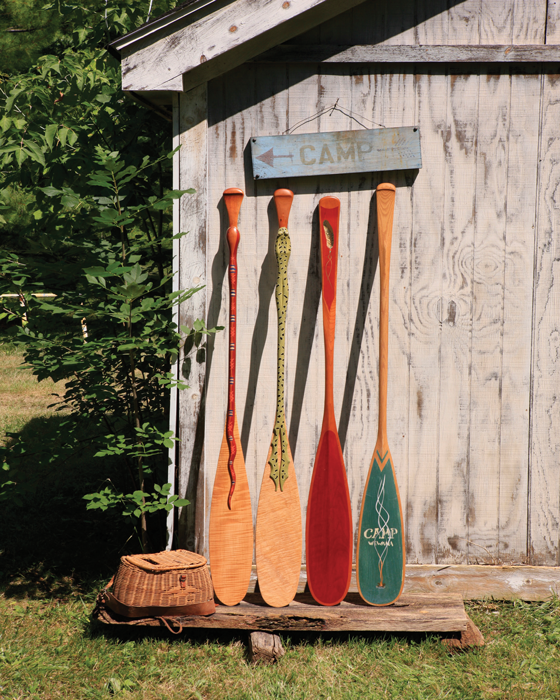Small boat building as an art form draws from a long and vast evolution of wood craftsmanship, from Native American dugout canoes and fur-hauling French bateaus to more modern artisanal designs.
Boat builder Allen Deming strives for the latter. His gleaming wood kayaks and canoes regularly turn heads — and collect fingerprints. People who see them want to touch them.
“There is something about wood that is natural and wholesome,” says Deming, owner of Mackinaw Watercraft in Grand Ledge. “My boats are wood, but don’t look like old-style boats.”
 Deming specializes in cedar-strip construction, a technique where narrow strips of light and dark cedar are glued together around a mold and are later brightly finished. He embellishes his vessels with wood inlay, using bits of colored, reclaimed woods to create abstract patterns or images of birds or trees.
Deming specializes in cedar-strip construction, a technique where narrow strips of light and dark cedar are glued together around a mold and are later brightly finished. He embellishes his vessels with wood inlay, using bits of colored, reclaimed woods to create abstract patterns or images of birds or trees.
An old redwood fence once provided the perfect design material.
“The inlays are inspired by traditional American quilters,” shares Deming, who left the corporate world in 2006 to pursue his passion. “When I look at a boat, I ask, ‘What can I do to make it unique?’ My wife Susan and I routinely have boats loaded on the truck and people ask us to pull over so they can look at them, or drive by and give us a thumbs-up.”
 Taking from 200 to 400 hours to create, the artisan’s specialty watercraft range between $2,000 and $7,000. Many are purchased for the water, he notes, but some are hung in cottages and rustic lodges.
Taking from 200 to 400 hours to create, the artisan’s specialty watercraft range between $2,000 and $7,000. Many are purchased for the water, he notes, but some are hung in cottages and rustic lodges.
Deming’s chosen woodcraft style was influenced by East Coast builder and designer Nick Schade, author of “The Strip-Built Sea Kayak” (1998, McGraw Hill Professional), a how-to guide Deming uses to teach others. Schade’s company, Guillemot Kayaks in Groton, Conn., is known for fine quality boats; his 18-foot “Night Heron” is displayed in New York City’s Museum of Modern Art.
“I fell in love with the strip designs,” Deming says. “They take more skill to build than a stitch and glue boat, but I like using woods from Michigan.”
While northern white cedar is used as the base material for most of Mackinaw Watercraft’s kayaks and canoes for its strength-to-weight ratio, beautiful grain and easy workability, Deming also incorporates ash, oak, walnut, poplar and birch, along with some exotic accents.
 Drifting On
Drifting On
Michigan woods are also the foundation for Phil Croff’s driftboats. The Alanson-based wood craftsman prefers white cedar and western red cedar for the wide, stable hulls he builds for swift northern rivers, which he augments with seats, casting braces and decks of walnut or zebrawood and oars made from Douglas fir and western grain cedar.
“I like cedar for its weatherablity and aesthetics,” says Croff, who left his career as a finish carpenter to launch Croff-Craft Custom Driftboats in 2006. “When you add red cedar to white cedar, it absolutely pops and you feel like you’re outdoors.”
 Croff’s two-seat boats sell for $14,000, personally delivered on a trailer. He also builds an exclusive 12-foot Orvis-Edition Croff-Craft for the Vermont-based fly fishing giant, which is showcased on the company website (orvis.com, see “Watercraft & Boats”).
Croff’s two-seat boats sell for $14,000, personally delivered on a trailer. He also builds an exclusive 12-foot Orvis-Edition Croff-Craft for the Vermont-based fly fishing giant, which is showcased on the company website (orvis.com, see “Watercraft & Boats”).
Croff notes his first boats were all about hull design — developing something stable from which to fish. Refining his wood choices and the best way to enhance their characteristics came later.

“I didn’t think about aesthetics when I started,” he says, “but these days I definitely have art in mind. I like to work with the striping theme: They’re beautiful to look at when it’s all done.”
Learn more at mackinawwatercraft.com and croffcraft.com.
— Howard Meyerson, Michigan BLUE Magazine.








Facebook Comments